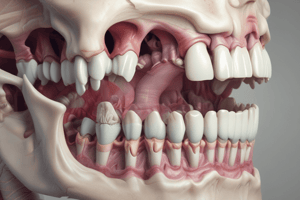Podcast
Questions and Answers
Which feature is NOT found on the external surface of the mandible?
Which feature is NOT found on the external surface of the mandible?
- Mental tubercles
- Mylohyoid ridge (correct)
- Mental foramen
- Mental protuberance
What is the part of the mandible that supports the teeth?
What is the part of the mandible that supports the teeth?
- Alveolar process (correct)
- Ramus
- Body of the mandible
- Coronoid process
Which of the following movements refers to the mandible moving backwards?
Which of the following movements refers to the mandible moving backwards?
- Retrusion (correct)
- Lateral deviation
- Protrusion
- Medial excursion
Which internal feature of the mandible is responsible for muscle attachment?
Which internal feature of the mandible is responsible for muscle attachment?
Which of the following defines the lateral excursion of the mandible?
Which of the following defines the lateral excursion of the mandible?
Flashcards
External oblique ridge
External oblique ridge
The external oblique ridge is a roughened ridge on the lateral surface of the mandible, extending from the anterior border of the ramus to the mental foramen.
Mental foramen
Mental foramen
The mental foramen is a small opening on the anterior surface of the mandible, below the second premolar tooth. It allows passage of the mental nerve and blood vessels.
Body of the mandible
Body of the mandible
The body of the mandible is the horizontal portion of the bone that forms the lower jawline.
Condyle of the mandible
Condyle of the mandible
Signup and view all the flashcards
Mandibular movements
Mandibular movements
Signup and view all the flashcards
Study Notes
External Features of the Mandible
- The mandible has an external oblique ridge.
- A mental foramen is present.
- The mental protuberance (chin) is a noticeable feature.
- Mental tubercles are also observed.
Internal Features of the Mandible
- Digastric fossae are present internally.
- The mental spine (genial tubercles) are internal structures.
- A mylohyoid ridge is an internal feature.
- A submandibular fossa is identified internally.
- A sublingual fossa is also present internally.
- The mandibular (inferior dental) foramen is located within the mandible.
Parts of the Mandible
- The body of the mandible is the main horizontal portion.
- The coronoid process is a prominent projection.
- The ramus is the vertical portion of the mandible.
- The condyle (head) and neck are articulating parts.
- The alveolar process is the tooth-bearing portion.
Mandibular Movement
- Opening and closing involve TMJ rotation and translation.
- Protrusion is forward movement in a straight line.
- Retrusion is backward movement.
- Lateral deviation is movement to the left or right.
- Lateral excursion is movement from one side to the other.
- Medial excursion is movement back toward the midline.
Studying That Suits You
Use AI to generate personalized quizzes and flashcards to suit your learning preferences.



